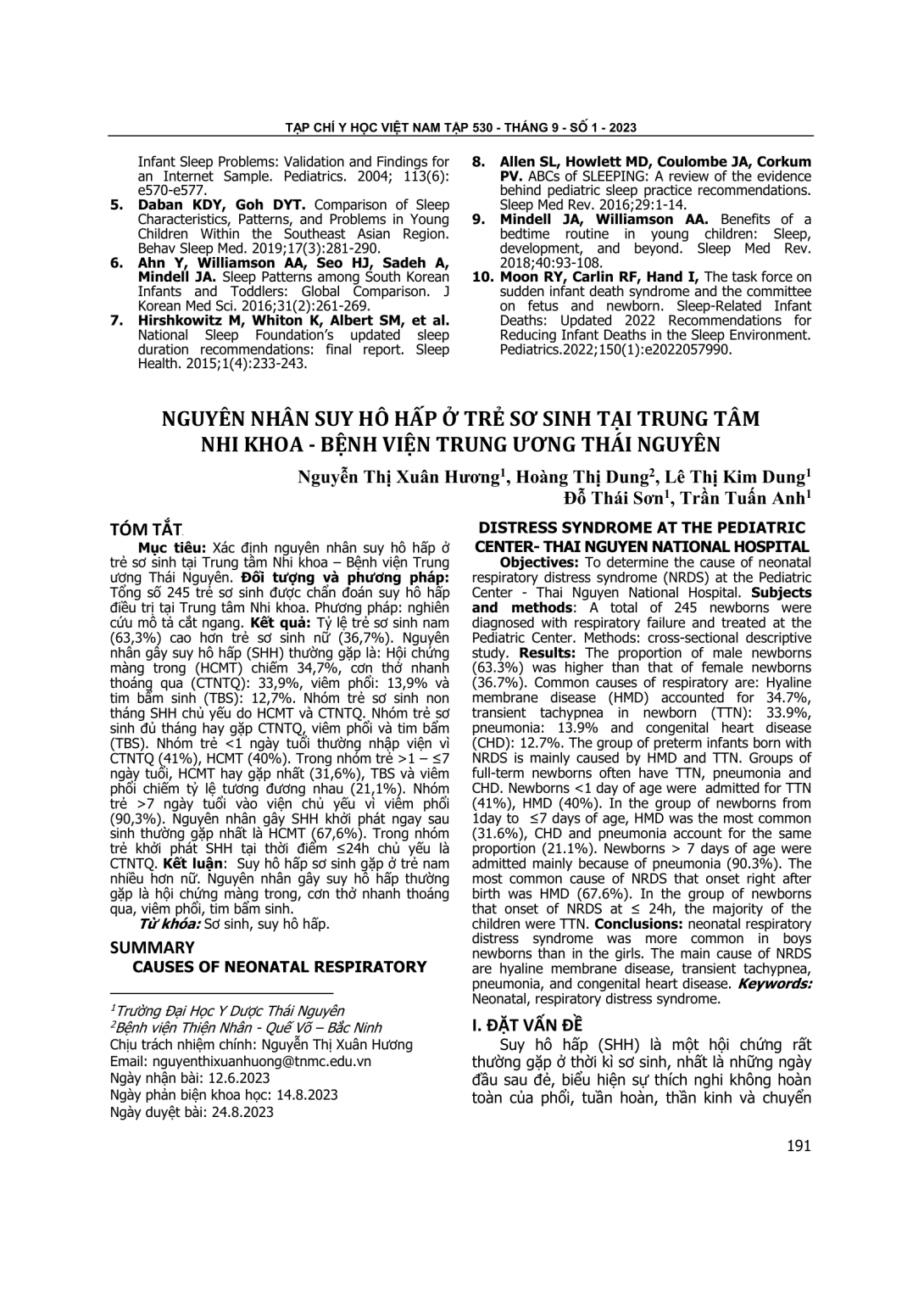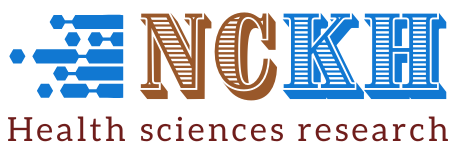
Xác định nguyên nhân suy hô hấp ở trẻ sơ sinh tại Trung tâm Nhi khoa – Bệnh viện Trung ương Thái Nguyên. Đối tượng và phương pháp: Tổng số 245 trẻ sơ sinh được chẩn đoán suy hô hấp điều trị tại Trung tâm Nhi khoa. Phương pháp: nghiên cứu mô tả cắt ngang. Kết quả: Tỷ lệ trẻ sơ sinh nam (63,3%) cao hơn trẻ sơ sinh nữ (36,7%). Nguyên nhân gây suy hô hấp (SHH) thường gặp là: Hội chứng màng trong (HCMT) chiếm 34,7%, cơn thở nhanh thoáng qua (CTNTQ): 33,9%, viêm phổi: 13,9% và tim bẩm sinh (TBS): 12,7%. Nhóm trẻ sơ sinh non tháng SHH chủ yếu do HCMT và CTNTQ. Nhóm trẻ sơ sinh đủ tháng hay gặp CTNTQ, viêm phổi và tim bẩm (TBS). Nhóm trẻ <1 ngày tuổi thường nhập viện vì CTNTQ (41%), HCMT (40%). Trong nhóm trẻ >1 – ≤7 ngày tuổi, HCMT hay gặp nhất (31,6%), TBS và viêm phổi chiếm tỷ lệ tương đương nhau (21,1%). Nhóm trẻ >7 ngày tuổi vào viện chủ yếu vì viêm phổi (90,3%). Nguyên nhân gây SHH khởi phát ngay sau sinh thường gặp nhất là HCMT (67,6%). Trong nhóm trẻ khởi phát SHH tại thời điểm ≤24h chủ yếu là CTNTQ. Kết luận: Suy hô hấp sơ sinh gặp ở trẻ nam nhiều hơn nữ. Nguyên nhân gây suy hô hấp thường gặp là hội chứng màng trong, cơn thở nhanh thoáng qua, viêm phổi, tim bẩm sinh.
To determine the cause of neonatal respiratory distress syndrome (NRDS) at the Pediatric Center - Thai Nguyen National Hospital. Subjects and methods: A total of 245 newborns were diagnosed with respiratory failure and treated at the Pediatric Center. Methods: cross-sectional descriptive study. Results: The proportion of male newborns (63.3%) was higher than that of female newborns (36.7%). Common causes of respiratory are: Hyaline membrane disease (HMD) accounted for 34.7%, transient tachypnea in newborn (TTN): 33.9%, pneumonia: 13.9% and congenital heart disease (CHD): 12.7%. The group of preterm infants born with NRDS is mainly caused by HMD and TTN. Groups of full-term newborns often have TTN, pneumonia and CHD. Newborns <1 day of age were admitted for TTN (41%), HMD (40%). In the group of newborns from 1day to ≤7 days of age, HMD was the most common (31.6%), CHD and pneumonia account for the same proportion (21.1%). Newborns > 7 days of age were admitted mainly because of pneumonia (90.3%). The most common cause of NRDS that onset right after birth was HMD (67.6%). In the group of newborns that onset of NRD To determine the cause of neonatal respiratory distress syndrome (NRDS) at the Pediatric Center - Thai Nguyen National Hospital. Subjects and methods: A total of 245 newborns were diagnosed with respiratory failure and treated at the Pediatric Center. Methods: cross-sectional descriptive study. Results: The proportion of male newborns (63.3%) was higher than that of female newborns (36.7%). Common causes of respiratory are: Hyaline membrane disease (HMD) accounted for 34.7%, transient tachypnea in newborn (TTN): 33.9%, pneumonia: 13.9% and congenital heart disease (CHD): 12.7%. The group of preterm infants born with NRDS is mainly caused by HMD and TTN. Groups of full-term newborns often have TTN, pneumonia and CHD. Newborns <1 day of age were admitted for TTN (41%), HMD (40%). In the group of newborns from 1day to ≤7 days of age, HMD was the most common (31.6%), CHD and pneumonia account for the same proportion (21.1%). Newborns > 7 days of age were admitted mainly because of pneumonia (90.3%). The most common cause of NRDS that onset right after birth was HMD (67.6%). In the group of newborns that onset of NRDS at ≤ 24h, the majority of the children were TTN. Conclusions: neonatal respiratory distress syndrome was more common in boys newborns than in the girls. The main cause of NRDS are hyaline membrane disease, transient tachypnea, pneumonia, and congenital heart disease.
- Đăng nhập để gửi ý kiến
